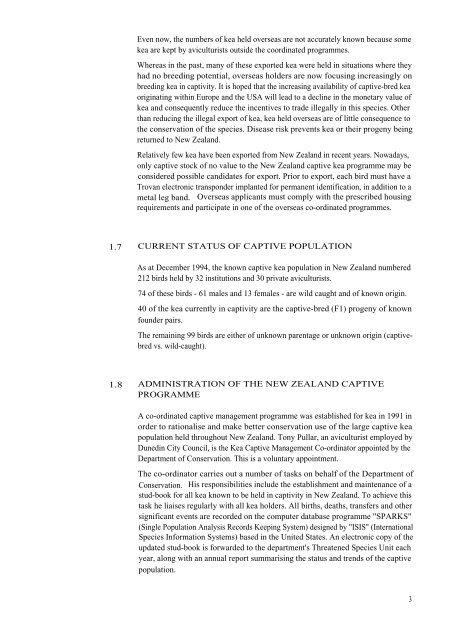Kea (Nestor notabilis) Captive Management Plan and Husbandry ...
Kea (Nestor notabilis) Captive Management Plan and Husbandry ...
Kea (Nestor notabilis) Captive Management Plan and Husbandry ...
You also want an ePaper? Increase the reach of your titles
YUMPU automatically turns print PDFs into web optimized ePapers that Google loves.
Even now, the numbers of kea held overseas are not accurately known because some<br />
kea are kept by aviculturists outside the coordinated programmes.<br />
Whereas in the past, many of these exported kea were held in situations where they<br />
had no breeding potential, overseas holders are now focusing increasingly on<br />
breeding kea in captivity. It is hoped that the increasing availability of captive-bred kea<br />
originating within Europe <strong>and</strong> the USA will lead to a decline in the monetary value of<br />
kea <strong>and</strong> consequently reduce the incentives to trade illegally in this species. Other<br />
than reducing the illegal export of kea, kea held overseas are of little consequence to<br />
the conservation of the species. Disease risk prevents kea or their progeny being<br />
returned to New Zeal<strong>and</strong>.<br />
Relatively few kea have been exported from New Zeal<strong>and</strong> in recent years. Nowadays,<br />
only captive stock of no value to the New Zeal<strong>and</strong> captive kea programme may be<br />
considered possible c<strong>and</strong>idates for export. Prior to export, each bird must have a<br />
Trovan electronic transponder implanted for permanent identification, in addition to a<br />
metal leg b<strong>and</strong>. Overseas applicants must comply with the prescribed housing<br />
requirements <strong>and</strong> participate in one of the overseas co-ordinated programmes.<br />
1.7 CURRENT STATUS OF CAPTIVE POPULATION<br />
As at December 1994, the known captive kea population in New Zeal<strong>and</strong> numbered<br />
212 birds held by 32 institutions <strong>and</strong> 30 private aviculturists.<br />
74 of these birds - 61 males <strong>and</strong> 13 females - are wild caught <strong>and</strong> of known origin.<br />
40 of the kea currently in captivity are the captive-bred (F1) progeny of known<br />
founder pairs.<br />
The remaining 99 birds are either of unknown parentage or unknown origin (captivebred<br />
vs. wild-caught).<br />
1.8 ADMINISTRATION OF THE NEW ZEALAND CAPTIVE<br />
PROGRAMME<br />
A co-ordinated captive management programme was established for kea in 1991 in<br />
order to rationalise <strong>and</strong> make better conservation use of the large captive kea<br />
population held throughout New Zeal<strong>and</strong>. Tony Pullar, an aviculturist employed by<br />
Dunedin City Council, is the <strong>Kea</strong> <strong>Captive</strong> <strong>Management</strong> Co-ordinator appointed by the<br />
Department of Conservation. This is a voluntary appointment.<br />
The co-ordinator carries out a number of tasks on behalf of the Department of<br />
Conservation. His responsibilities include the establishment <strong>and</strong> maintenance of a<br />
stud-book for all kea known to be held in captivity in New Zeal<strong>and</strong>. To achieve this<br />
task he liaises regularly with all kea holders. All births, deaths, transfers <strong>and</strong> other<br />
significant events are recorded on the computer database programme "SPARKS"<br />
(Single Population Analysis Records Keeping System) designed by "ISIS" (International<br />
Species Information Systems) based in the United States. An electronic copy of the<br />
updated stud-book is forwarded to the department's Threatened Species Unit each<br />
year, along with an annual report summarising the status <strong>and</strong> trends of the captive<br />
population.<br />
3












